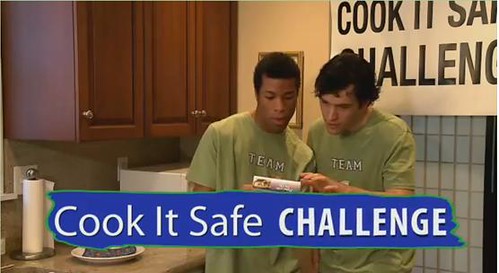This month, USDA’s Food Safety and Inspection Service is taking part in a “Cook It Safe” campaign to raise awareness about the need to follow package instructions in order to fully cook pre-prepared foods and prevent foodborne illness. Due to illnesses in recent years resulting from undercooked pre-prepared meals, the “Cook It Safe!” campaign urges consumers to follow four key food safety tips to be sure food is fully and safely prepared at home:
1. Read and Follow Package Cooking Instructions
Frozen or refrigerated convenience foods may appear ready-to-eat and simply in need of being reheated, but many contain raw products that must be fully cooked before eating. The product’s label should tell whether reheating or thorough cooking is needed. Don’t ignore steps like covering, stirring halfway through cooking, or allowing food to rest before eating—these steps contribute to even cooking.
2. Know When to Use a Microwave or Conventional Oven
Use the appliance indicated on food package instructions, whether that is a conventional oven, convection oven, toaster oven, or microwave. Some products may appear fully cooked but actually consist of raw product. While it’s tempting to cook these foods quickly in a microwave, doing so could result in undercooking and possible food poisoning. Irregularly shaped foods create opportunities for uneven cooking in a microwave and therefore must be cooked in an oven. Regardless of the appliance, always check for doneness with a food thermometer (see tip #4).
3. Know Your Microwave’s Wattage
The higher the microwave’s wattage, the faster food will cook. If your microwave’s wattage is lower than the package cooking instructions recommend, adjust the cooking time to fully cook your meal. A microwave’s wattage can be found inside the door, on the serial number plate, or in the owner's manual. Or, estimate the wattage based on the time it takes cold tap water to boil in a “Time-to-Boil” test.
4. Use a Food Thermometer
To ensure food has reached a temperature high enough to kill harmful bacteria that may be present, test the food in several places with a food thermometer, regardless of which appliance you are using. This chart shows at what temperature your pre-prepared meal is fully cooked and safe to eat.

Throughout September, the Cook It Safe taskforce will provide blog posts on each of these four tips at www.foodinsight.org/nutrition-blog.aspx. View campaign public service announcements here, and follow @USDAFoodSafety and @FoodInsight on Twitter for Cook It Safe updates.
